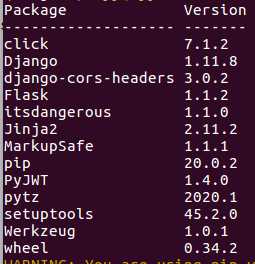前后端分离——博客项目
Posted sd-xyy
tags:
篇首语:本文由小常识网(cha138.com)小编为大家整理,主要介绍了前后端分离——博客项目相关的知识,希望对你有一定的参考价值。
1 初始化 django 博客项目步骤:
创建新虚拟环境, 安装各种包:
$ mkvirtualenv xinjian
$ cd xinjian/
$ pip install django==1.11.8
$ python steup.py install
$ pip install PyJWT.whl
$ django-admin startproject blog_server

2 更改settings.py 设置:
ALLOWED_HOSTS = [‘*‘]
MIDDLEWARE = [
‘django.middleware.security.SecurityMiddleware‘,
‘django.contrib.sessions.middleware.SessionMiddleware‘,
‘corsheaders.middleware.CorsMiddleware‘,
‘django.middleware.common.CommonMiddleware‘,
将csrf禁用掉
#‘django.middleware.csrf.CsrfViewMiddleware‘,
LANGUAGE_CODE = ‘zh-Hans‘
TIME_ZONE = ‘Asia/Shanghai‘
3 创建数据库:
$ mysql -u root -p
创建数据库:
create database blog_server default charset utf8 collate utf8_general_ci;
4 更改settings.py数据库设置:
DATABASES = { ‘default‘: { ‘ENGINE‘: ‘django.db.backends.mysql‘, ‘NAME‘: ‘blog_server‘, ‘USER‘: ‘root‘, ‘PASSWORD‘: ‘123456‘, ‘HOST‘: ‘127.0.0.1‘, ‘PORT‘: ‘3306‘ } }
5 更改settings.py设置

1 1,INSTALLED_APPS 中添加 corsheaders 2 3 2,MIDDLEWARE 中添加 corsheaders.middleware.CorsMiddleware 4 位置尽量靠前,官方建议 ‘django.middleware.common.CommonMiddleware’ 上方 5 3,CORS_ORIGIN_ALLOW_ALL= True 布尔值 如果为True 白名单不启用,写在文件的最后面 6 4,CORS_ORIGIN_WHITELIST =[ #指定白名单,一般不用写 7 "https://example.com" 8 ] 9 5, CORS_ALLOW_METHODS = ( 10 ‘DELETE‘, 11 ‘GET‘, 12 ‘OPTIONS‘, 13 ‘PATCH‘, 14 ‘POST‘, 15 ‘PUT‘, 16 ) 17 6, CORS_ALLOW_HEADERS = ( 18 ‘accept-encoding‘, 19 ‘authorization‘, 20 ‘content-type‘, 21 ‘dnt‘, 22 ‘origin‘, 23 ‘user-agent‘, 24 ‘x-csrftoken‘, 25 ‘x-requested-with‘, 26 ) 27 7, CORS_PREFLIGHT_MAX_AGE 默认 86400s 28 8, CORS_EXPOSE_HEADERS [] 扩展头 29 9, CORS_ALLOW_CREDENTIALS 布尔值, 默认False 30 31 32 33 34 import os 35 36 37 38 ALLOWED_HOSTS = [‘*‘] 39 40 41 # Application definition 42 43 INSTALLED_APPS = [ 44 45 ‘corsheaders‘, 46 ‘user‘ 47 ] 48 49 MIDDLEWARE = [ 50 ‘django.middleware.security.SecurityMiddleware‘, 51 ‘django.contrib.sessions.middleware.SessionMiddleware‘, 52 ‘corsheaders.middleware.CorsMiddleware‘, 53 ‘django.middleware.common.CommonMiddleware‘, 54 #‘django.middleware.csrf.CsrfViewMiddleware‘, 55 ] 56 57 # Database 58 # https://docs.djangoproject.com/en/1.11/ref/settings/#databases 59 60 DATABASES = { 61 ‘default‘: { 62 ‘ENGINE‘: ‘django.db.backends.mysql‘, 63 ‘NAME‘: ‘blog_server‘, 64 ‘USER‘: ‘root‘, 65 ‘PASSWORD‘: ‘123456‘, 66 ‘HOST‘: ‘127.0.0.1‘, 67 ‘PORT‘: ‘3306‘ 68 } 69 } 70 71 LANGUAGE_CODE = ‘zh-Hans‘ 72 73 TIME_ZONE = ‘Asia/Shanghai‘ 74 75 USE_I18N = True 76 77 USE_L10N = True 78 79 USE_TZ = True 80 81 STATIC_URL = ‘/static/‘ 82 83 CORS_ORIGIN_ALLOW_ALL = True 84 85 CORS_ALLOW_METHODS = ( 86 ‘DELETE‘, 87 ‘GET‘, 88 ‘OPTIONS‘, 89 ‘PATCH‘, 90 ‘POST‘, 91 ‘PUT‘, 92 ) 93 94 CORS_ALLOW_HEADERS = ( 95 ‘accept-encoding‘, 96 ‘authorization‘, 97 ‘content-type‘, 98 ‘dnt‘, 99 ‘origin‘, 100 ‘user-agent‘, 101 ‘x-csrftoken‘, 102 ‘x-requested-with‘, 103 ) 104 105 #关掉路由自动补全 106 APPEND_SLASH = False
6 blog_server/urls.py:
from django.conf.urls import url, include
from django.contrib import admin from . import views urlpatterns = [ url(r‘^admin/‘, admin.site.urls), url(r‘^test_api‘, views.test_api), #添加user模块 url映射 url(r‘v1/users‘, include(‘user.urls‘)), #添加btoken模块 url映射, 该模块用登录操作 url(r‘v1/token‘, include(‘btoken.urls‘)) ]
7 新建blog_server/views.py:
from django.http import JsonResponse def test_api(request): #JsonResponse 1,将返回内容序列化成json #2,response中添加 content-type: application/json return JsonResponse({‘code‘:200})
8 在虚拟环境安装flask
pip install flask
9 创建文件包 client, 并创建 flask_client.py文件
 iew Code
iew Code
10 创建client/static/的css, js, images 包, 并创建各种文件
11 创建模板:

<!DOCTYPE html> <html> <!-- author:guojunyu date:2019-05 desc:this demo is about blog. PLEASE NOTE:If you have trouble running it ,try any of the other demos or connect with auther. A ny individuals and organizations and not for commercial use, professiona website for customized web site. --> <head> <meta charset="utf-8"> <meta name="viewport" content="width=device-width, initial-scale=1"> <link rel="stylesheet" href="/static/css/login_reglogin.css"/> <script src="/static/js/jquery.min.js" type="text/javascript"></script> <title>登陆</title> </head> <body> <div class="bg"> <img src="/static/images/b.jpg" alt=""> </div> <div class="main"> <div class="header" > <h1>Login!</h1> </div> <p></p> <ul class="right-form"> <h2>Login:</h2> <li><input type="text" class="username" name="username" placeholder="Username" required/></li> <li><input type="password" class="password" name="password" placeholder="Password" required/></li> <input type="button" value="登录" onclick="login()"> <div class="clear"> </div> </ul> <div class="clear"> </div> </div> </body> <script> function login(){ var username = $(‘.username‘).val() var password = $(‘.password‘).val() var post_data = {‘username‘:username, ‘password‘:password } $.ajax({ // 请求方式 type:"post", // contentType contentType:"application/json", // dataType dataType:"json", // url url:"http://127.0.0.1:8000/v1/tokens", // 把JS的对象或数组序列化一个json 字符串 data:JSON.stringify(post_data), // result 为请求的返回结果对象 success:function (result) { if (200 == result.code){ window.localStorage.setItem(‘dnblog_token‘, result.data.token) window.localStorage.setItem(‘dnblog_user‘, result.username) alert(‘登陆成功‘) refer_url = document.referrer //如果是项目内部的请求,回跳到上一步 if (refer_url.search(‘127.0.0.1‘) != -1){ window.location = refer_url; }else{ window.location = ‘/‘ + result.username + ‘/topics‘; } }else{ alert(result.error) } } }); } </script> </html>
以上是关于前后端分离——博客项目的主要内容,如果未能解决你的问题,请参考以下文章
